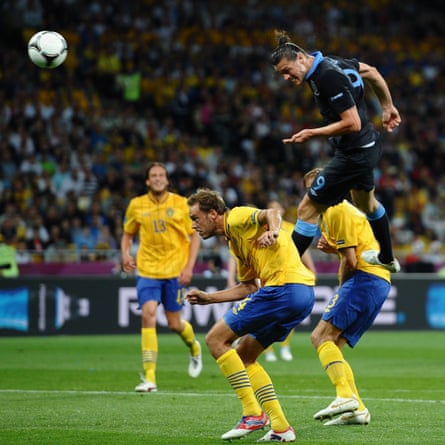When the time comes for a big screen Andy Carroll biopic it may be a good idea to start with a chase scene. Perhaps even that traumatic attempted heist three years ago when a man on a moped stopped Carroll’s jeep after training and tried to get him to hand over his watch.
It led to some heroic quick reactions. Key details include Carroll crashing into “at least 10” cars as he drove away. Carroll shouting “I’m a Premier League footballer!” at the emergency services as he fled his pursuers. And Carroll heading rather sweetly not for the nearest police station but back to the West Ham training ground, like an antelope released into the wild and retracing the tyre tracks of its handlers, seeking the closest thing to home.
Looking back now it feels an entire sporting career captured in one image.
The collisions, the sense of a juggernaut surging past pursued by furies, ponytail flapping in silhouette against the flames. At the criminal trial it emerged Carroll’s attacker was found cowering in terror under a mattress. Let’s face it, he probably wasn’t hiding from the police.
But then Carroll’s career has always had something stirring and elemental about it. This is a footballer gifted a wonderful range of pre-industrial talents just as we entered the digital age; cursed by serious and repeated injury; and now left rusting like a cold-war destroyer after his seven-year spell at West Ham came to an end at the start of this month.
Look down the list and Carroll is one of many big names currently out of contract. The summer window offers the chance to snap up an entire Roy Hodgson-era England strike force, with Daniel Sturridge and Danny Welbeck also unattached, both waiting for the dog days of mid-August where fans grow restless, anxieties start to rise and the clock strikes West Ham.
With Carroll it feels, as ever, as though some wider story is being played out. It has been a strange 13 years at the top. His move to Liverpool in 2011 made him the most expensive British footballer. The last seven years have brought only 33 Premier League goals. But through that time Carroll’s influence has been oddly unignorable. This is a career that has no real narrative, no feeling of events progressing naturally from one to the next, which has instead unspooled around a series of striking, potent images.
Another Carroll scene: that goal in Kiev for England against Sweden at Euro 2012. Watch it back now and it remains a startling piece of skill. Steven Gerrard piles in a deep swirling cross. Carroll rises above the yellow shirts, filling the skies like a burning zeppelin. Finally he wrenches his neck muscles, not so much heading the ball as butting it with a thrilling fury into the corner of the net. At the time it felt like the start of something. Carroll was 23 years old.
This was his first competitive goal for England. It also turned out to be his last. These days it feels as though Carroll’s England career was an era-spanning collision of style and intent, the embodiment of something entrenched, the old English football of the skies.
In reality Carroll barely featured at all. He played his last England game only three months after that Sweden goal. In the meantime his only Premier League goals in the last two and half years have come against West Brom, Stoke and Hull City, a Carroll goal acting as a kind of death-mark, sure sign of looming relegation.

In part this is a feature of those long injury absences. But really football has changed around him. Carroll first played for Newcastle in 2006, when English football was still baffled by the idea the game didn’t have to be played in a series of orderly straight lines. Even then Carroll was more than just a bludgeon. He could link the play, with a fine touch, and was brilliant at pressing defences in his youth. It is only later, as his movement has congealed, that the focus has been solely on his aerial craft.
It still has its use as a corrective force. Another Carroll scene: his last great moment, the eight-minute hat-trick against Arsenal in 2016, when Carroll seemed to overwhelm a decadent late-Wenger defence like a mountain landslip, like an angry buffalo hurled from a hotel balcony, like 1500 tons of refrigerated corned beef dumped into the waves by a stricken supertanker, like nemesis, the revenge of nature; or like a competent centre-forward taking advantage of slack marking on crosses to the back post.
There were calls in the days that followed for Carroll to be “parachuted” into the Euro 2016 squad (Carroll is always being parachuted, deployed or unleashed). But even then it felt like a last breath of something. As of this season pretty much everything Carroll does in a penalty area will be declared illegal by VAR – a hand on the shoulder here, a high-velocity aerial body-slam there.
The Premier League video panel may as well just pixelate him out of the feed, as football has been keen to do to his type, the full-contact players, ever since the rules began to change, with great vindication elsewhere.
There is a sadness to all this. Carroll really does seem to love football, even as it has pushed him from place to place. And while sympathy will be in short supply – sympathy is always in short supply – he is also a victim.
Carroll’s early career was lived through the years when players were treated like a kind of social experiment, subjected to relentless irradiating forces. Hurl riches their way. Bombard them with negative attention. Let’s see what peculiar shapes we can bend this human material into.
Aged 30, there is still hope of something more. The dream move would, of course, be a return to Newcastle, where he was a ball boy and a fan, and where he never really wanted to leave.
Most things don’t happen. This one probably won’t. Glorious homecomings rarely work out, in any case. But Carroll has always seemed to exist beyond the cold facts, an emblem of football as something more immediate and more emotional; a man out of his time from the start of his time, who might just have one last big scene left.

